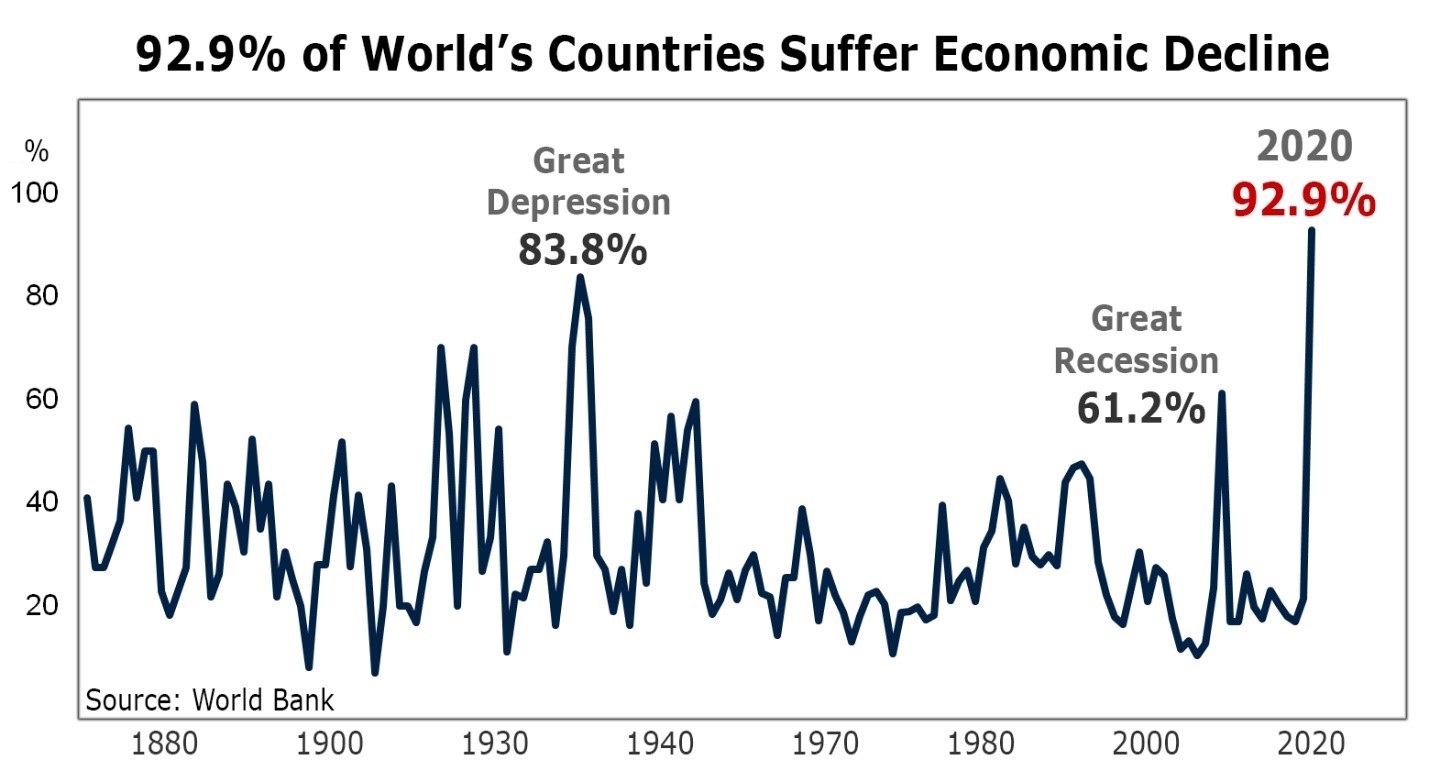World Bank: Most Widespread Depression in Recorded History
 |
 |
We don’t have economic data from the 14th century when the Black Death swept through Asia, Europe and Africa.
We certainly don’t know much about the great floods that struck the Middle East and Central Asia thousands of years ago.
But we do have reliable GDP numbers going back to the 1800s. And based on that data set, the World Bank has just issued a very startling analysis:
In 2009, the Great Recession reached 61.2% of the world’s countries.
In 1931, the Great Depression impacted 83.8%.
In other periods — the terrible 1880s, World War I and World War II — the collapse rarely reached more than 60% of the countries.
But 2020 is the worst of all.
The economic depression sweeping the globe is the most widespread in recorded history: A whopping 92.9% of the world’s countries are sinking into the economic morass.
That’s one alarming fact. Here are four more …
U.S. — worse than Great Depression. The U.S. economy will suffer a steeper plunge this year than it did in the worst year of the Great Depression: In 2020, the World Bank expects GDP to contract by a shocking 6.1%; back in 1932, it sank by “only” 5.3%.
Japan — no better than U.S. despite mild pandemic. Despite the fact that the pandemic in Japan has been far less severe, the depression will be just as bad, with GDP down the same 6.1% as in the United States.
Europe — even worse! The European economy, which was already teetering before the pandemic, will suffer the most of all — GDP will be crushed with an unimaginable decline of 9.1%!
Recoveries in 2021 — anemic. The combined GDP of the U.S., Europe and Japan will sink 7% in 2020, but will only recover by 3.9% in 2021.
All this represents the most current nonpartisan forecast from any major governmental body.
It’s substantially more pessimistic than the already-gloomy predictions issued earlier by the U.S. Congressional Budget Office and the Federal Reserve.
And it still does not take into account some of the looming dangers we have repeatedly documented here …
Unprecedented overleveraging by giant corporations.
Unheard-of monetary madness by the world’s central banks.
Unstoppable escalation in the global trade war.
Unpredictable social and political fallout.
What will all these unmeasurable factors do to the so-called “recovery” expected in 2021?
How will it impact your stock portfolio?
And most important …
What are you going to do about it?
As I see it, you have three choices …
- You, cover your eyes with one hand, follow Wall Street, and swing for the fences with the other …
- You can freeze like a deer in the headlights and just hold everything, or …
- You can promptly take prudent steps to prepare.
I strongly urge the third choice. And a good place to start is by reducing your exposure to stocks with the lowest Weiss Stock Ratings. Here’s how to identify them …
Go to www.weissratings.com.
At the top of the page, you will find a search window like this:
 |
At the right side of the search window, click on the down arrow.
Select the category “stocks.” This is important because we also issue Weiss Safety Ratings on banks and other financial institutions. But for this purpose, what you want is the Weiss Stock Ratings.)
Enter the company name or ticker symbol as shown.
Seriously consider selling stocks rated “D+” or lower. Just bear in mind that, in a broad bear market, higher rated stocks can also lose value.
Then, for any stocks you hold in your portfolio, create a Weiss Ratings Watchlist and be sure to add them to the list. That way, whenever our rating for your stock changes, we’ll be sure to send you an email alert.
Good luck and God bless!


